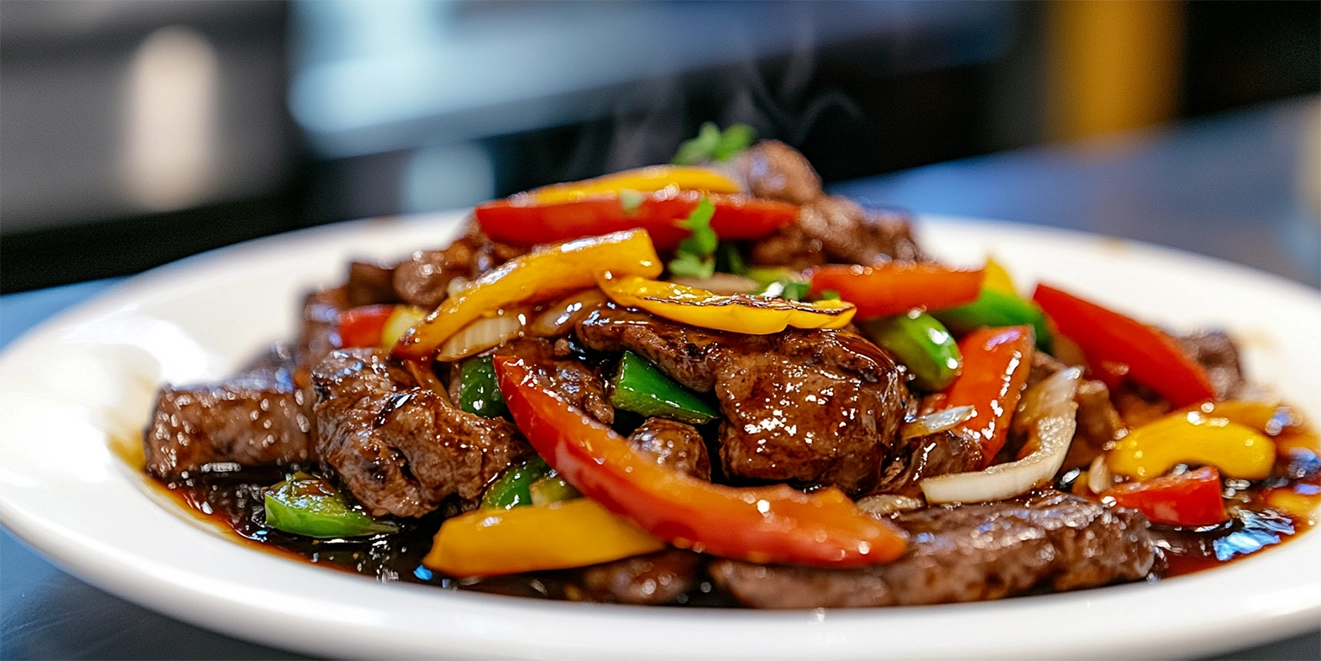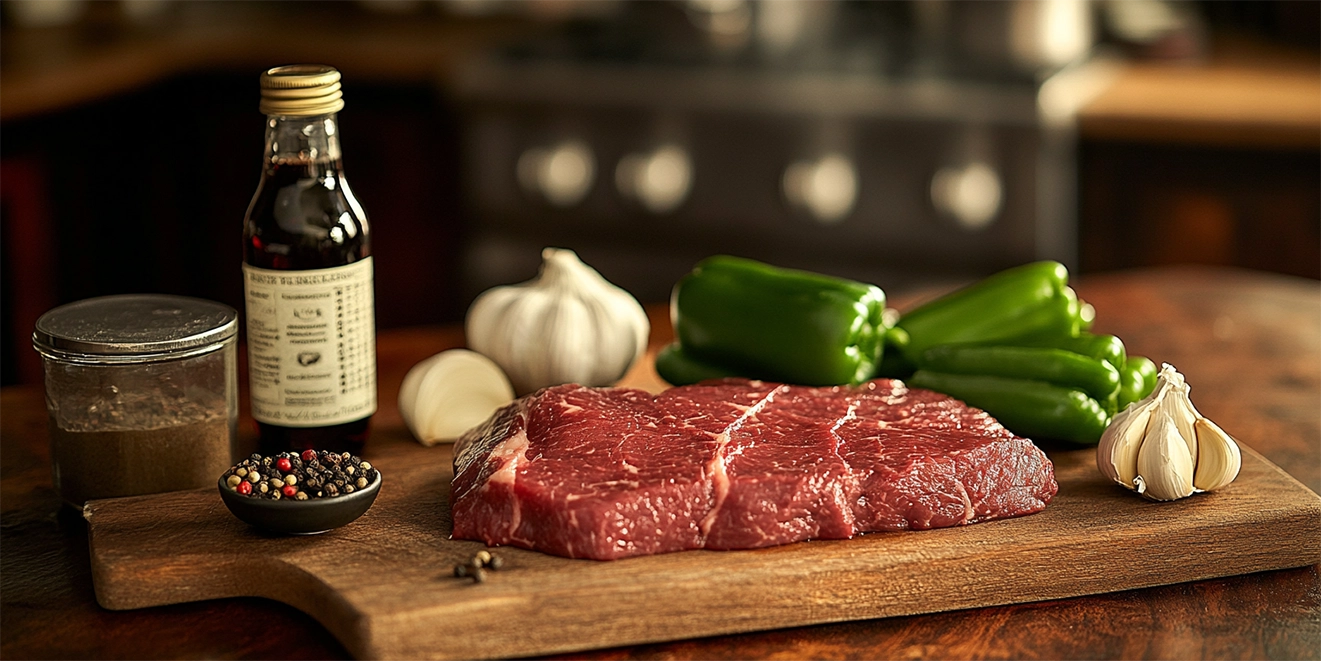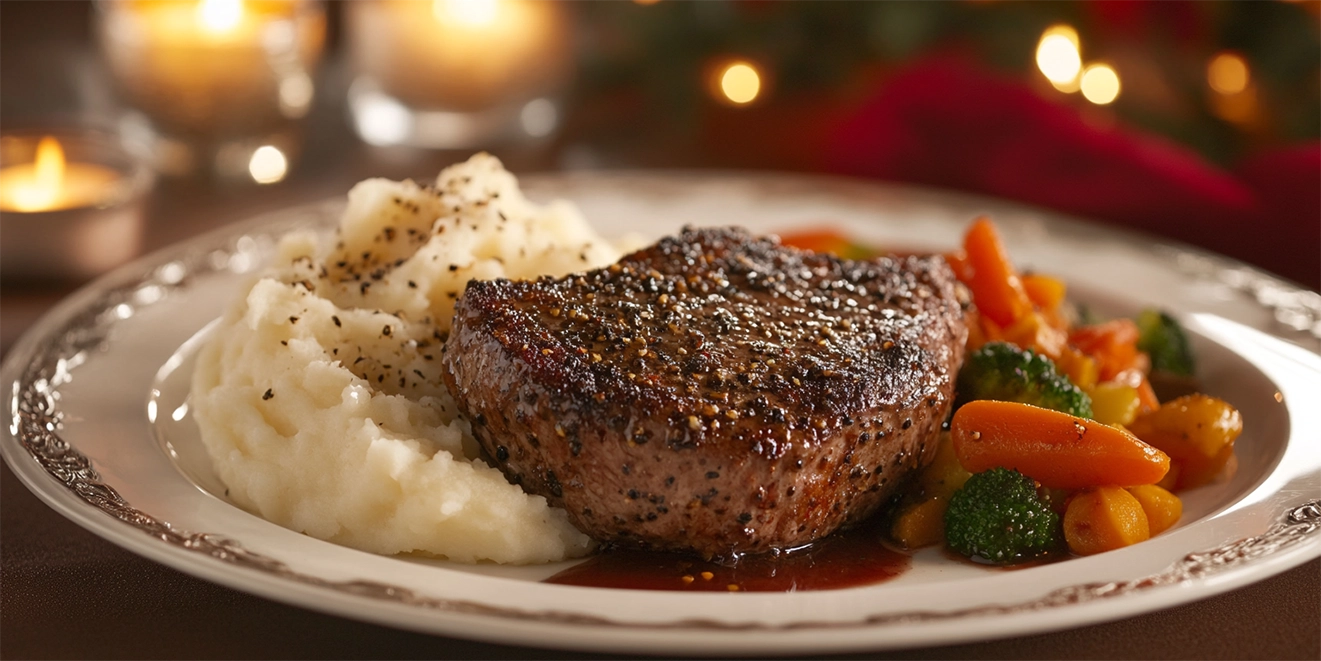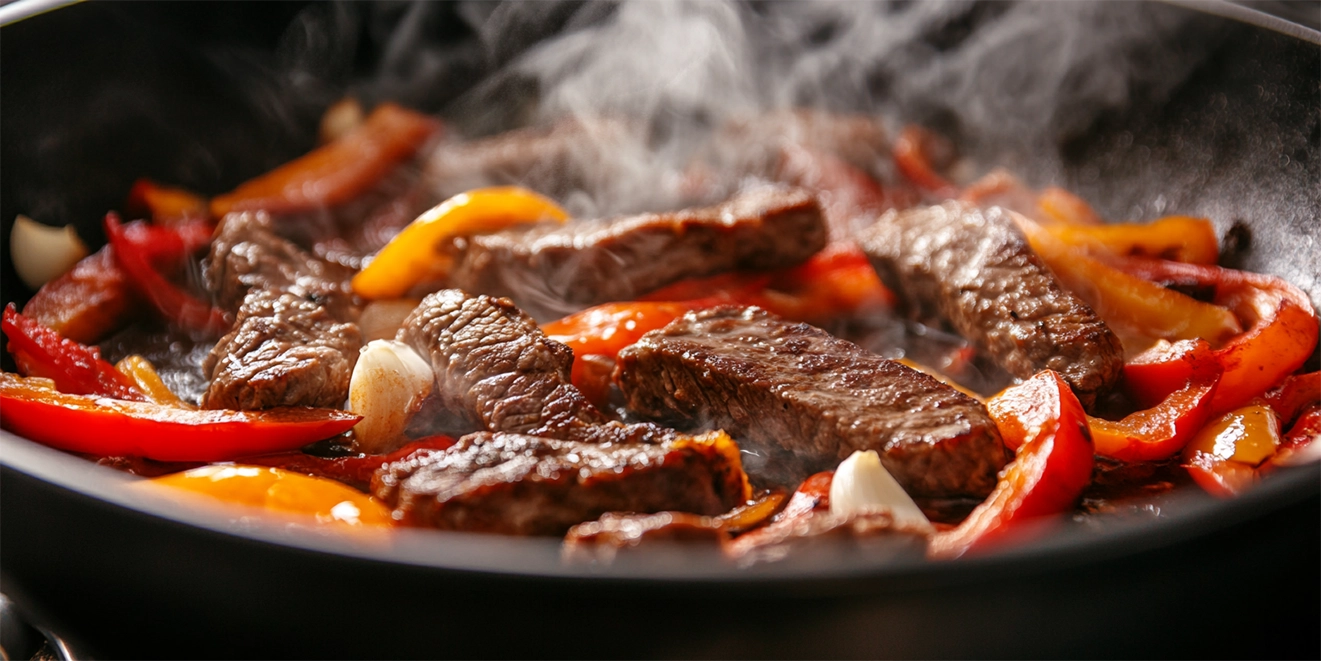
Table of Contents
Introduction to Pepper Steak
What is Pepper Steak?
Pepper steak is a savory dish typically featuring tender pieces of beef cooked with a flavorful combination of black pepper, onions, bell peppers, and other vegetables. It is known for its bold, spicy, and aromatic flavor profile, with the peppercorns offering a distinctive kick. The beef is usually stir-fried or pan-seared to ensure it retains its juiciness and tenderness, while the seasoning enhances the dish’s overall taste.
Overview of Its Popularity Worldwide
Pepper steak enjoys widespread popularity across many regions, especially in Asian and Western cuisines. In the United States, it is often found in Chinese-American restaurants as a stir-fry dish, while in parts of Europe and Africa, variations of pepper steak may include different types of beef cuts and spices. Its versatile flavor and simple ingredients make it a beloved dish for home cooks and chefs. The combination of heat from black pepper with the richness of beef makes it a go-to meal for those seeking a comforting yet exciting culinary experience.
Tracing the Roots of Pepper Steak
The Origins of Stir-Frying
Stir-frying, a key cooking technique in many Asian dishes, including pepper steak, originated in China over 2,000 years ago during the Han Dynasty. This method involves quickly cooking ingredients in a small amount of hot oil over high heat while constantly stirring. Stir-frying was developed to preserve the texture and nutrients of vegetables and proteins, making it an efficient and healthy cooking technique. Over time, stir-frying spread to other Asian countries and eventually to the West, becoming popular for creating flavorful, fast-cooked meals like pepper steak.
Early History of Beef in Chinese Cuisine
While beef is now a staple in Chinese cuisine, it was only sometimes as prominent. Historically, Chinese cuisine focused more on pork, chicken, and fish, with beef being less common due to cultural and geographical factors. However, during the Tang Dynasty (618–907 AD), beef became Chinese cooking, particularly in the northern regions where cattle were more commonly raised. Over the centuries, beef dishes became more widespread, and by the 20th century, beef stir-fries, such as pepper steak, began to emerge in Chinese restaurants, especially in the United States. The dish blends the traditional stir-frying technique with the bold flavors of black pepper, making it a favorite in Chinese-American and international cuisine today.
Influence of Chinese Cuisine
Chinese Cooking Techniques and Ingredients
Chinese cuisine is known for its diverse and refined cooking techniques, many of which have influenced dishes like pepper steak. Key techniques such as stir-frying, steaming, braising, and deep-frying emphasize high heat and quick cooking to preserve ingredients’ natural flavors and textures. Stir-frying, in particular, is central to Chinese cuisine and is used extensively for meat and vegetable dishes like pepper steak.
Chinese cooking also uses a variety of unique ingredients that contribute to the distinct flavors of its dishes. Common ingredients include soy sauce, oyster sauce, ginger, garlic, rice wine, and sesame oil, which add depth and complexity to the food. Black pepper and soy sauce are crucial for pepper steak, providing a balance of spice and umami that defines the dish.
Adaptation of Traditional Recipes
As Chinese cuisine spread across the globe, it adapted to local tastes and available ingredients, creating fusion dishes like pepper steak. In Western countries, particularly in the United States, Chinese-American chefs began modifying traditional Chinese recipes to suit their customers’ preferences. This often involved adjusting the spice level, incorporating more beef (as opposed to pork or chicken), and using locally available vegetables. For instance, the use of black pepper in pepper steak was a variation that catered to the Western love for bolder, spicier flavors.
Key Ingredients in Traditional Pepper Steak

Types of Beef Used
The quality of beef is crucial to the success of pepper steak. Typically, tender cuts of meat are used, as they cook quickly and absorb the flavors of the seasonings. Common choices include flank steak, sirloin, or rib-eye, known for their tenderness and rich flavor. These cuts are usually sliced thinly against the grain to ensure a tender bite and to allow the seasoning to penetrate the meat more effectively. Some variations of pepper steak may also use other cuts, depending on regional preferences or availability.
Bell Peppers and Sauces
Bell peppers are a key ingredient in pepper steak, adding color and sweetness to balance the heat of the black pepper. Red, green, and yellow bell peppers are commonly used, offering a variety of textures and flavors. The peppers are typically sliced into strips or chunks and stir-fried alongside the beef, providing a crunchy contrast to the tender meat.
Sauces are another critical component of pepper steak. A combination of soy sauce, oyster sauce, and sometimes hoisin sauce or black bean sauce is often used to enhance the dish’s flavor. These sauces contribute a savory umami taste, helping to round out the dish. Soy sauce adds saltiness and depth, while oyster sauce provides a subtle sweetness and rich flavor, making the sauce mixture complex and balanced.
Importance of Fresh Ingredients
Using fresh ingredients is essential for creating a delicious and vibrant pepper steak. Fresh beef ensures a tender and juicy texture, while fresh bell peppers provide a crisp and refreshing bite. Fresh ginger, garlic, and green onions are often added to enhance the aroma and flavor profile of the dish. Using fresh ingredients ensures the dish maintains its natural flavors and allows the cooking technique to shine, resulting in a flavorful, well-balanced meal. Additionally, fresh ingredients help preserve the dish’s health benefits, making it both tasty and nutritious.
Perfecting the Art of Cooking Pepper Steak
Pepper steak is a savory and flavorful dish that combines tender beef, crisp bell peppers, and a rich, glossy sauce. It’s a go-to for quick weeknight meals or an impressive dinner party dish. This guide will walk you through preparing the perfect pepper steak.
Ingredients
Before diving into the cooking process, gather the following ingredients:
- 1 lb of flank steak, sliced thinly
- Two bell peppers (any color), julienned
- One onion, sliced
- Three cloves of garlic, minced
- 2 tbsp soy sauce
- 1 tbsp oyster sauce
- 1 tbsp cornstarch mixed with 2 tbsp water (for slurry)
- Salt and pepper to taste
- 2 tbsp cooking oil
You can explore other variations for a deeper flavor profile, as discussed in our chuck roast recipe.
Step-by-Step Preparation
- Marinate the Beef
- Start by marinating the sliced steak in soy sauce, a dash of oyster sauce, and black pepper for about 20 minutes. This enhances the flavor and tenderizes the meat.
- Sear the Meat
- Heat oil in a wok or large skillet over high heat. Sear the beef until it’s browned and set aside. For more tips on searing meat, check out our smoked brisket recipe.
- Cook the Vegetables
- In the same pan, sauté the garlic, onion, and bell peppers until slightly softened but still crisp. This technique ensures a delightful crunch in every bite.
- Prepare the Sauce
- Mix soy sauce, oyster sauce, and the cornstarch slurry in a bowl. Pour this mixture into the pan, bringing it to a simmer. Add the beef back and cook until the sauce thickens and evenly coats the steak and vegetables.
- Serve
- Serve hot with steamed rice or over noodles for a comforting, complete meal. Please read our guide on what pairs well with swordfish for side pairing ideas.
Tips for the Best Pepper Steak
- Use fresh, high-quality bell peppers to add vibrant color and crunch.
- For a spicier kick, add crushed red pepper or sliced chili.
- Ensure the sauce consistency is smooth by adjusting the cornstarch slurry.
If you’re looking to expand your culinary skills further, explore our collection of hearty chicken casserole recipes and diverse shrimp pasta recipes.
Evolution of the Dish Over Time

Changes in Ingredients and Preparation Methods
Pepper steak has evolved significantly over time, mainly as it spread beyond its Chinese origins. The basic concept of stir-fried beef with peppers and a savory sauce remains consistent, but ingredients and preparation methods have adapted to suit regional tastes and available products.
In the early versions of pepper steak, ingredients were simple, focusing primarily on beef, black pepper, and a basic soy-based sauce. Over time, as the dish traveled to different parts of the world, new ingredients were introduced. For example, in Western adaptations, other vegetables like mushrooms or onions became standard, while additional spices and seasonings such as garlic and ginger enhanced the flavor profile.
The preparation method has also evolved. While traditional Chinese pepper steak might involve stir-frying in a wok, modern variations may include grilling or even slow-cooking the beef to enhance its tenderness. The dish is sometimes served with rice or noodles, making it a more filling meal than its earlier, simpler versions.
Influence of Local Flavors Globally
As pepper steak gained popularity internationally, local flavors and culinary traditions began influencing the dish. In North America, for example, pepper steak became a staple in Chinese-American restaurants, where chefs adapted the recipe by increasing the spice level and using different cuts of beef, such as sirloin or rib-eye. Some variations also incorporate a sweeter flavor profile, adding ingredients like bell peppers, pineapple, or even ketchup, reflecting the American preference for sweeter and bolder tastes.
In the Caribbean, pepper steak may be prepared with a more robust seasoning, often incorporating local ingredients such as Scotch bonnet peppers, thyme, and allspice, adding heat and aromatic complexity. Similarly, in Southeast Asia, the dish may include a variety of local herbs and spices like lemongrass, cilantro, and fish sauce, reflecting the region’s unique culinary influences.
Overall, pepper steak’s evolution is a testament to how food adapts to local cultures and ingredients while maintaining the core elements that make it a beloved dish worldwide. The result is a familiar and versatile dish capable of taking on various forms while retaining its essential identity.
Cooking Techniques

The Art of Stir-Frying
Stir-frying is a cornerstone of Chinese cooking and plays a key role in preparing pepper steak. This technique involves cooking ingredients quickly in a small amount of oil over high heat while constantly stirring. The goal is to rapidly sear the beef, vegetables, and spices to retain their flavor, color, and texture. Stir-frying ensures the meat stays tender and juicy while the vegetables retain a crispness that contrasts beautifully with the beef. The key to successful stir-frying is maintaining high heat so the ingredients cook quickly and evenly without becoming soggy or overcooked.
Importance of Wok Cooking
The wok’s unique shape allows for even heat distribution and facilitates the tossing and stirring of ingredients. The high, sloping sides of a wok help the food stay contained while it cooks quickly, and the wide, flat bottom provides ample space for searing the beef. Using a wok is essential because it keeps the ingredients in constant motion, ensuring that each piece of meat and vegetable is evenly cooked and coated with the sauce.
While you can stir-fry in other pans, the wok’s design is unmatched for achieving the right balance of heat and movement. This is especially important for dishes like pepper steak, where maintaining the ideal texture of beef and vegetables is essential for the dish’s success.
Common Mistakes to Avoid
To achieve the perfect pepper steak, there are several common mistakes to avoid during preparation:
- Overcrowding the Pan: One of the most common mistakes is overcrowding the wok or pan with too many ingredients. When this happens, the food steams instead of stir-fries, which results in soggy vegetables and tough meat. To avoid this, cook the beef in batches, ensuring each piece has enough room to sear properly.
- Not Preheating the Pan: Stir-frying requires high heat to quickly sear the meat and vegetables. If the pan isn’t hot enough when you start cooking, the food will release moisture and become steamed rather than crisp and caramelized. Always preheat the wok or pan before adding oil.
- Using the Wrong Oil: Using the wrong oil can affect flavor and cooking. Avoid oils with low smoke points, like olive oil, as they can burn and create an unpleasant taste. Instead, opt for oils with higher smoke points, such as vegetable, peanut, or sesame, which are ideal for stir-frying.
- Underseasoning or Overseasoning: Balancing the seasoning is key to a successful pepper steak. Be careful not to underseason, as the beef and vegetables need the right amount of soy sauce, oyster sauce, and pepper to enhance their natural flavors. On the other hand, overdoing it can make the dish too salty or overwhelming. Taste the sauce before serving to ensure it’s well-balanced.
- Overcooking the Beef: Since stir-frying is quick, the beef can quickly become overcooked and tough. To prevent this, cut the meat into thin slices against the grain and cook it for a short time until it reaches the desired level of doneness.
Frequently Asked Questions (FAQs)
Who invented pepper steak?
The origin of pepper steak is difficult to pinpoint, as it has evolved through different cultures. The dish is commonly associated with Chinese cuisine, specifically in Chinese-American cooking, where stir-fried beef with black pepper became popular in the mid-20th century. However, variations of pepper steak have been made in different parts of the world, and various regional flavors and cooking techniques likely influenced the dish.
Where is peppercorn steak from?
Peppercorn steak is believed to have originated in France, particularly in French bistros, where it is commonly referred to as “steak au poivre.” The French version typically involves a steak coated with crushed black peppercorns, which are then seared to form a crust and served with a rich peppercorn sauce. The peppercorn steak has since influenced international versions, including the popular stir-fry style known as pepper steak in Chinese-American cuisine.
What country does steak originate from?
Steak, as a dish consisting of a cut of beef, doesn’t have a specific country of origin, as the practice of cooking meat in this way has been common in many cultures. However, steak as we know it today, particularly in grilled or pan-seared cuts of beef, has strong roots in European culinary traditions, especially in countries like France, England, and Spain. The concept of grilling meat has also been integral to the cuisines of many cultures, including the United States and Argentina, where beef is a central part of the national identity.
Conclusion: The Global Appeal of Pepper Steak
Originating from Chinese cuisine, it has evolved through cultural adaptations, with regional variations enhancing its richness and appeal. Whether it’s the traditional stir fry version. with bell peppers and soy sauce or the classic French peppercorn steak, the dish showcases the perfect balance of heat, savory depth, and tender beef.
From Americanized versions served with fries to modern, delicate dining dishes using premium cuts of beef and sophisticated sauces, pepper steak continues to evolve while staying true to its roots.
For More Delicious Recipes, Follow Us at QuickyCookRecipes.com!
Follow Us on Facebook, Pinterest, or Instagram for More Fast & Easy Meals!
